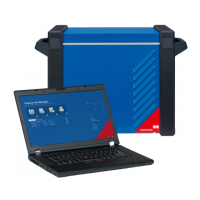OMICRON 233
Off-service diagnostic methods
The following table explains the sequences of the Timing (CSM) test.
Table 17-72: Timing (CSM) test sequences
Sequence Action
O With this sequence, the opening time of the circuit breaker is measured.
Only for O and C sequences we recommend performing the test twice, once
with nominal voltage and once with 20% undervoltage to assure the
functionality of the circuit breaker for a weak station battery.
C This is the sequence to measure the closing time of the circuit breaker.
OC With this sequence, a closing operation after the circuit breaker has tripped
to clear a fault is simulated.
Initially, the circuit breaker must be in the closed position. An open
command initiates the sequence, followed by a dead time to clear the fault;
and finally a close command must close the circuit breaker. This sequence
is also known as reclosing sequence. To find out the shortest reclosing time
the circuit breaker can provide, the close command is already applied while
the circuit breaker is still opening. The circuit breaker then will close after
opening as fast as possible.
CO With this sequence, a tripping operation after the circuit breaker has been
closed under a fault condition (trip-free) or the verification of the correct
operation of the anti-pumping system is simulated.
To test the trip-free time the circuit breaker must be in the open position
before the test is started. The circuit breaker is closed and then during the
close operation is still in progress an open command is sent. The circuit
breaker then opens as fast as possible.
To test the anti-pumping function of the circuit breaker, the circuit breaker
must be in closed position before the test is started. For this test the open
time is set shorter (typically 200 ms) than the closing time (typically 400 ms).
Ensure that the end time is increased so that the test sequence covers the
whole close command duration (typically at least 190 ms). When the close
command is sent the circuit breaker is already closed which initiates the
anti-pumping function. Then an open command is sent and the circuit
breaker trips. The closing command is still on when the open command
ends, but the circuit breaker should not "pump", so that it should not close
again.
O-CO With this sequence, a reclose sequence (OC) under a fault condition is
simulated. If the fault is not released, the circuit breaker must open (O)
immediately and remain in this position.
Initially, the circuit breaker must be in the closed position. The sequence
begins with an open command, after a dead time the close and open
commands (CO) must be applied at the same time (delay time typically
300 ms).

